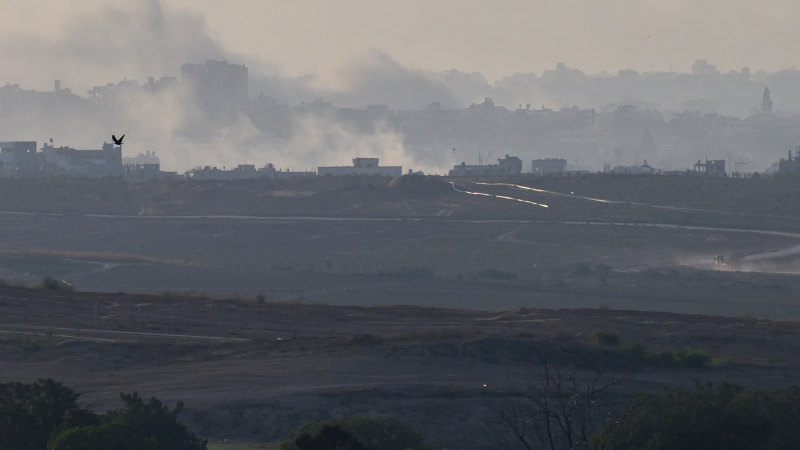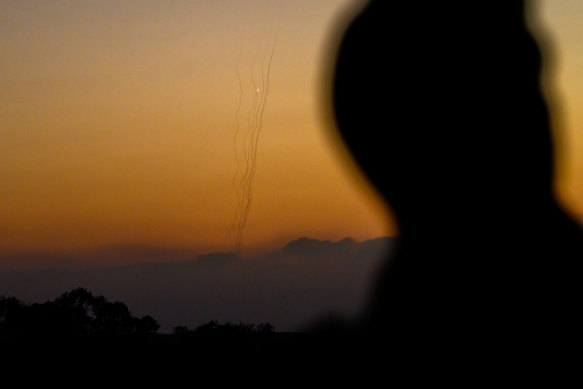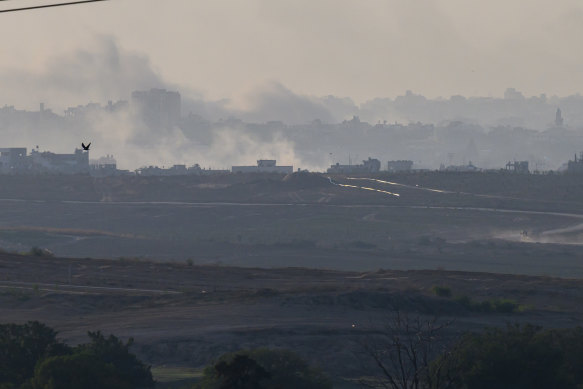Israel appears to shrug off US warnings to protect civilians in Gaza’s south
Save articles for later
Add articles to your saved list and come back to them any time.
Washington: The US insisted to Israel this week that it come up with clear plans to minimise civilian harm in any military operation in southern Gaza, a senior US official said, as the Israeli military resumed bombardment of the enclave after a week-long truce collapsed.
By Friday evening, Israel-time, Gaza health officials said Israeli air strikes had killed 184 people, wounded at least 589 others and hit more than 20 houses.
A soldier watches as rockets are fired from Gaza into Israel from Sderot, Israel. Credit: Getty
Friday’s bombing was most intense in the southern areas of Khan Younis and Rafah, medics and witnesses said. Hundreds of thousands of Gazans have been sheltering there because of fighting in the north. Houses in central and northern areas were also hit.
The Israeli Defence Forces (IDF) had indicated it would move into southern Gaza when hostilities resumed having already taken control of much of the north.
It dropped leaflets over Khan Younis, a city of 200,000 people during the conflict had taken in many Palestinians forced out of the heavily populated north Gaza Strip. The United Nations says about two-thirds of Gaza’s 2.3 million residents are homeless.
When the IDF entered Gaza City it oversaw the evacuation of hundreds of thousands of people to the south but now, as it moves its offensive there, it is not clear where displaced people will be able to go.
Khan Younis is eight kilometres from the Rafah crossing at the Egyptian border, but Egypt is adamant it will not take on refugees.
It has rebuked suggestions the Palestinian people could be relocated to the Sinai Desert, a largely unpopulated expanse of land in Egypt’s east.
Friday’s bombings in the south occurred only hours after US Secretary of State Antony Blinken told Israeli Prime Minister Benjamin Netanyahu during a visit to Jerusalem that Israel’s operations in the area not repeat the massive loss of civilian life and displacement seen during its northern offensive.
Israel’s government agreed that any operation in the south should not look like it did in the north and its military will designate areas where civilians will not be harmed, the senior US official said as Blinken wrapped up a trip to the region.
Smoke rises from Gaza as Israel’s strikes resume.Credit: Getty
However, Netanyahu and his government did not give clear assurances on avoiding civilian harm, and the official said the issue will continue to be discussed.
The official added that the US expects there will be no full-scale assault on Khan Younis and Rafah as there was on Gaza City.
Washington has urged Israel to narrow the zone of combat and clarify where Palestinian civilians can seek safety in southern Gaza, officials have said.
The official, speaking on condition of anonymity on Friday, said during the current offensive entire neighbourhoods in southern Gaza should be designated as zones that are safe for civilians, though some may still have to leave their homes if they are in areas where Hamas fighters are deeply embedded.
Israel has sworn to annihilate Hamas in response to the October 7 rampage by the militant group, when Israel says gunmen killed 1200 people and took 240 hostages. Hamas, sworn to Israel’s destruction, has ruled Gaza since 2007.
In addition to those who planned the October 7 attacks, Israel was looking to eliminate Hamas’ battalion-level leadership, said the official.
Israel’s assault has laid waste to much of Gaza. Palestinian health authorities deemed reliable by the United Nations say more than 15,000 Gazans have been confirmed killed and thousands more are missing and feared buried under rubble.
Asked at Dubai airport before leaving the region about the collapse of the truce and Israel’s conduct on Friday, Blinken signalled Washington would continue dialogue with Israel.
“I saw the plans that Israel has, in a multiplicity of ways, to do everything possible to protect civilians, including making sure that they have the information they need and there are ways to accommodate them. And this is going to be very important going forward. It’s something we’re going to be looking at very closely,” Blinken said.
In related news, a protester with a Palestinian flag self-immolated on Friday, US-time, outside the Israeli consulate in Atlanta, authorities said.
The person, whom officials did not identify, is in critical condition, Police Chief Darin Schierbaum said at a news conference. A security guard who attempted to intervene was also injured.
“We believe this building remains safe, and we do not see any threat here,” the chief said. “We believe that was an act of extreme political protest.”
The protester arrived around 12.17pm at the office building, which houses the consulate as well as several businesses, and used petrol, police said.
US Secretary of State Antony Blinken.Credit: AP
“We are saddened to learn of the self-immolation at the entrance to the office building,” the consul general of Israel to the southeastern US, Anat Sultan-Dadon, told ABC News US. “It is tragic to see the hate and incitement toward Israel expressed in such a horrific way. The sanctity of life is our highest value.”
with James Lemon
Reuters
More coverage of the Hamas-Israel conflict
- Hamas had bigger plans on October 7: Intelligence about Hamas’ motivations reveals an intention to strike a blow of historic proportions and provoke an overwhelming Israeli response.
- Escape from chaos: An Australian father faced a heartbreaking dilemma – whether to flee Gaza to his children, or stay with his wife.
- Open letters: Mass resignations, boardroom turmoil and angry donors are some of the ways the Israel-Hamas war is filtering down into Australia’s high-powered arts world.
- Gaza’s youth: One of the cruellest ironies of wars is that they are never started by children, yet it is children who suffer the most.
Get a note directly from our foreign correspondents on what’s making headlines around the world. Sign up for our weekly What in the World newsletter.
Most Viewed in World
From our partners
Source: Read Full Article




